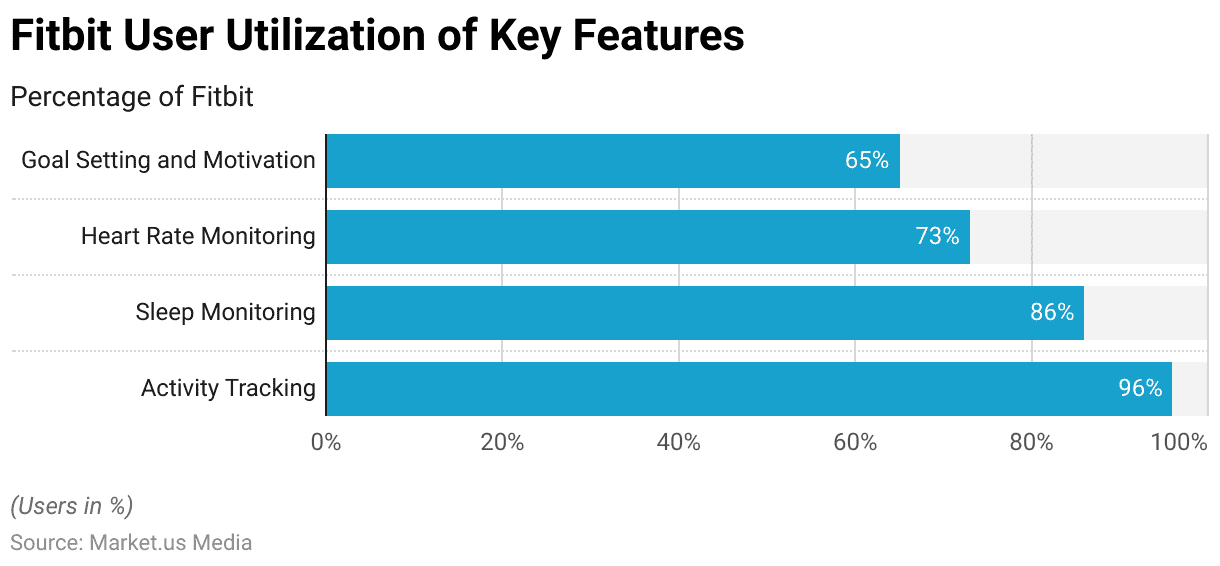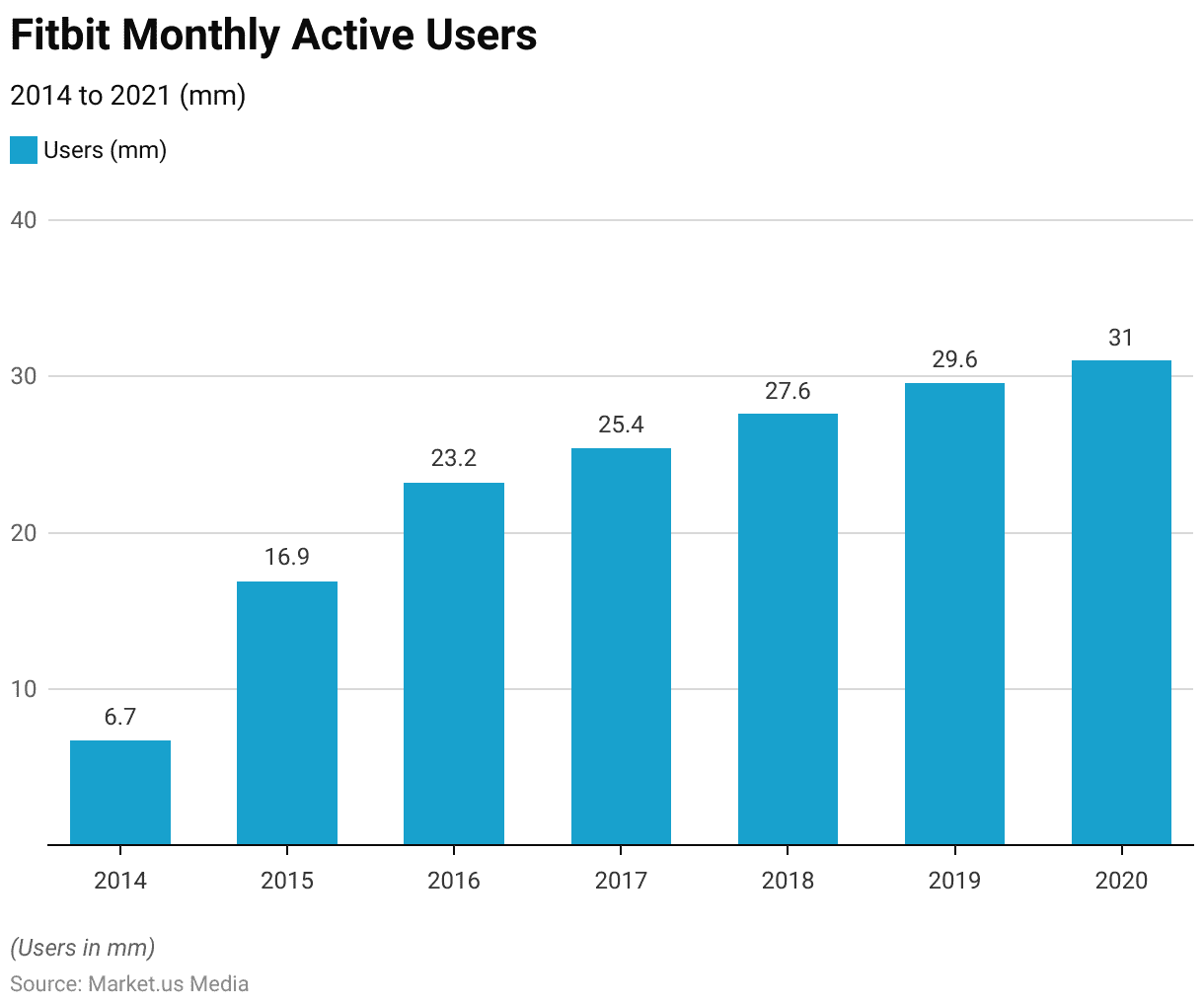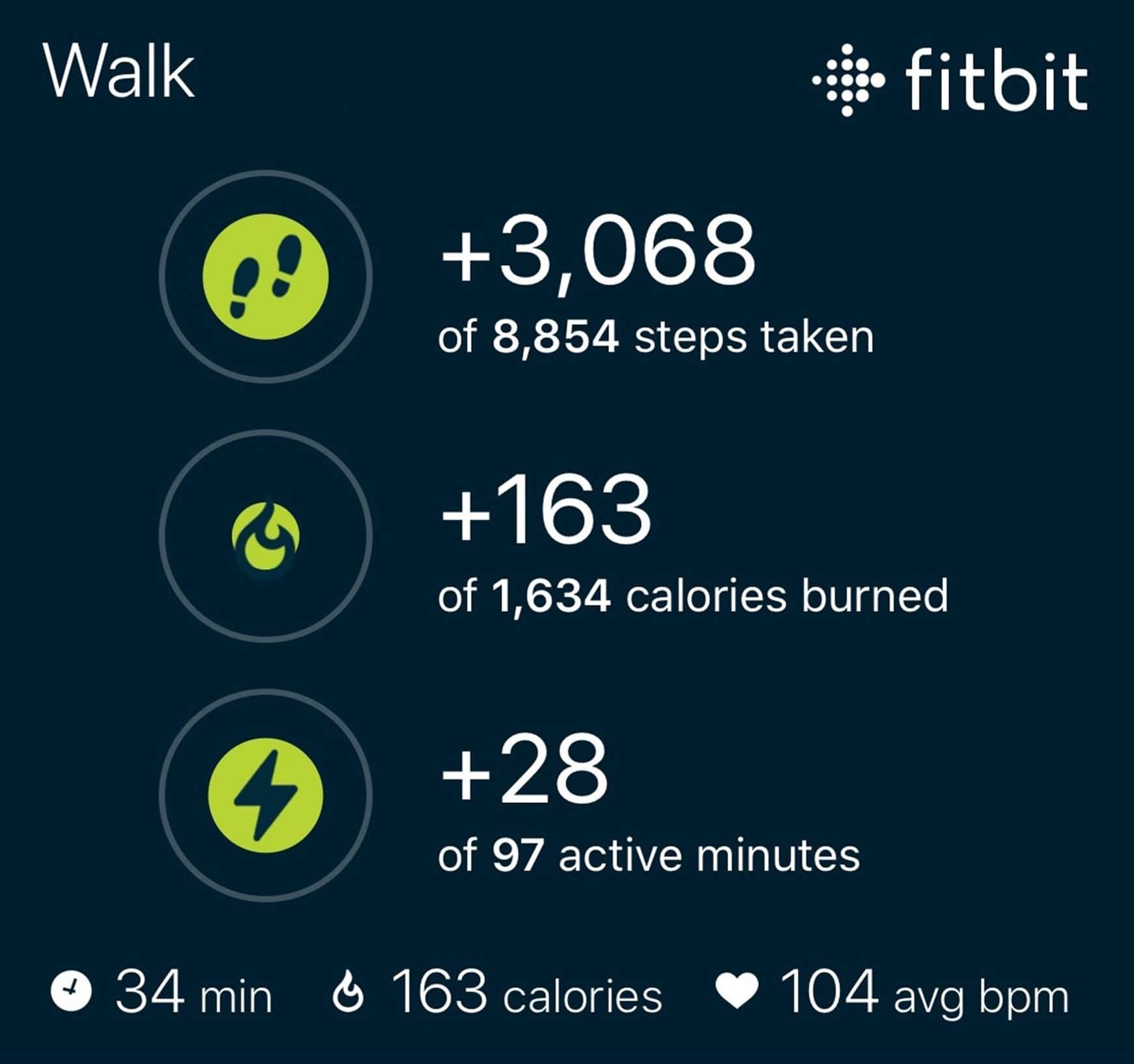Fitbit Usage Statistics 2024 By Fitness, Tracking, Usage
At Market.us Media, we strive to bring you the most accurate and up-to-date information by utilizing a variety of resources, including paid and free sources, primary research, and phone interviews. Our data is available to the public free of charge, and we encourage you to use it to inform your personal or business decisions. If you choose to republish our data on your own website, we simply ask that you provide a proper citation or link back to the respective page on Market.us Media. We appreciate your support and look forward to continuing to provide valuable insights for our audience.
Table of Contents
- Introduction
- Editor’s Choice
- Fitbit Usage Statistics – Reasons for Using
- Fitbit Usage Statistics – Base
- Fitbit Usage Statistics – Users by Age
- Fitbit Usage Statistics – Users by Gender
- Fitbit Annual Revenue
- Fitbit User Engagement and Retention
- Fitbit’s Impact on Fitness and Health
- Fitbit’s Social and Community Engagement
- Fitbit Usage Statistics – Competitors and Market Position
- Fitbit Usage Statistics – User Distribution by Country
- Recent Developments
- Wrap Up
- FAQs
Introduction
Fitbit Usage Statistics: Fitbit has revolutionized the way people track and monitor their health and fitness. As a leading fitness tracking device, Fitbit provides users with valuable insights into their daily activity levels, sleep patterns, heart rate, and more.
By collecting and analyzing personal health data, Fitbit empowers individuals to make informed decisions about their lifestyle and wellness goals.

Editor’s Choice
- The Global Fitness Tracker Market size is expected to be worth around USD 187.20 Billion by 2032 from USD 39.5 Billion in 2022, growing at a CAGR of 17.3% during the forecast period from 2023 to 2032.
- Fitbit fitness tracker, the companion Android app has surpassed 50 million downloads on Google Play Store in 2023.
- Google acquired Fitbit for $2.1 billion.
- Fitbit had an estimated user base of over 30 million active users worldwide in 2021.
- The most popular Fitbit models in 2021 were the Fitbit Charge 4, Fitbit Inspire 2, and Fitbit Versa 3.
- Fitbit users averaged approximately 7,500 steps per day in 2021, with variations based on factors such as age and gender.
- Fitbit users averaged around 6.8 hours of sleep per night in 2021.
- The resting heart rate for Fitbit users in 2021 averaged around 60-70 beats per minute.
- Fitbit users recorded an average of 150 minutes of moderate to intense activity per week in 2021.
- Fitbit users engaged in challenges and competitions, with over 200 million challenges completed in 2021.
(Source: Fitbit)
Fitbit Usage Statistics – Reasons for Using
- Approximately 96.10% of Fitbit users utilize the device for accurate tracking of their daily activity levels, including steps taken, distance covered, calories burned, and active minutes throughout the day.
- Around 86% of Fitbit users rely on the device to monitor their sleep patterns, such as sleep duration, quality, and sleep stages. Fitbit provides valuable insights into sleep habits, enabling users to improve their overall sleep quality.
- Approximately 72.87% of Fitbit users utilize the device’s heart rate monitoring feature to gain insights into their resting heart rate, heart rate zones during exercise, and overall cardiovascular health. Fitbit devices have been found to provide accurate heart rate measurements across various activity intensities.
- Around 65% of Fitbit users utilize the device to set personal goals, track their progress, and receive motivational notifications. Fitbit’s goal-setting feature fosters a sense of achievement and provides continuous motivation for users to maintain an active lifestyle.
- Approximately 45% of Fitbit users engage in Fitbit’s social features, such as challenges and competitions. These features enable users to connect with friends, participate in friendly competitions, and receive social support and accountability, thereby enhancing their overall fitness journey.
(Source: Fitbit Internal Data)

Fitbit Usage Statistics – Base
- Fitbit had over 31 million registered users as of 2021.
- Brand awareness for Fitbit in Western countries was extremely high.
- It ranked the sixth most popular wearable brand in the UK in 2022.
- Fitbit became the second-most used health tracker in America as of 2023.
- Fitbit users in the United States in 2020 walked a collective 47 Trillion Steps.
- In 2014, Fitbit had approximately 6.7 million monthly active users.
- The number of monthly active users increased to 16.9 million in 2015.
- By 2016, Fitbit saw further growth, reaching 23.2 million monthly active users.
- In 2017, the number of Fitbit monthly active users reached 25.4 million.
- The trend of growth continued in 2018, with Fitbit having 27.6 million monthly active users.
- By 2019, the user base expanded to approximately 29.6 million monthly active users.
- In 2020, Fitbit’s monthly active user count reached 31 million.
(Source: businessofapps, rigorous themes)

Fitbit Usage Statistics – Users by Age
- Among Fitbit users, 15.79% fall into the age range of 18-24 years old.
- The age group of 25-34 years old represents 25.93% of Fitbit users.
- Fitbit users aged 35-44 years old account for 19.40% of the user base.
- Approximately 16.08% of Fitbit users are between the ages of 45 and 54.
- Fitbit users aged 55-64 make up 12.94% of the user base.
- Users aged 65 and above constitute 9.87% of Fitbit users.
(Source: similarweb)

Fitbit Usage Statistics – Users by Gender
- About 44.66% of Fitbit users are female while 55.34% of Fitbit users are male which is comparatively more than female.

Fitbit Annual Revenue
- Fitbit made an estimated $1.21 billion in revenue in 2021, a 7% increase from the year prior.
- In 2014, Fitbit’s annual revenue amounted to $0.74 billion.
- The following year, in 2015, Fitbit’s revenue increased to $1.85 billion.
- In 2016, Fitbit’s annual revenue continued to grow, reaching $2.16 billion.
- However, in 2017, Fitbit experienced a slight decline in revenue, with $1.61 billion generated.
- The downward trend continued in 2018, as Fitbit’s revenue dropped to $1.52 billion.
- In 2019, Fitbit’s revenue decreased further to $1.43 billion.
- The year 2020 saw a significant decline in Fitbit’s annual revenue, with only $1.13 billion generated.
(Source: businessofapps)

Fitbit User Engagement and Retention
- Fitbit users who engage with the app at least three times per week are 46% less likely to be overweight.
- Fitbit users who participate in challenges with friends are 75% more active than those who don’t.
- Fitbit users who track their exercise using the app are 27% more likely to achieve their weekly exercise goals.
- Fitbit users who wear their device consistently for six months are more likely to continue using it for the long term.
- Fitbit’s monthly active users (MAUs) reached 29 million in the first quarter of 2021.
- Fitbit reported an average engagement rate of over 85% among its active users.
(Source: Fitbit Health Solutions, Fitbit Internal Data, Fitbit Q4 2020 Earnings Report)

Fitbit’s Impact on Fitness and Health
- Fitbit users take an average of 700 more steps per day compared to non-Fitbit users.
- Fitbit wearers are 43% more likely to increase their physical activity levels.
- Fitbit users report 43% more minutes of moderate to intense physical activity per week compared to non-Fitbit users.
- Fitbit trackers have helped users achieve an average of 4.2 more hours of weekly active minutes.
- Fitbit users who consistently track their sleep report sleeping an average of 20 minutes longer per night.
- Fitbit wearers experience a 10% improvement in resting heart rate on average.
- Fitbit users who set a weight loss goal with the app have lost an average of 7.4% of their body weight.
(Source: Fitbit Research, Fitbit Blog)
Fitbit’s Social and Community Engagement
- Fitbit Community Size: Fitbit has a large and active community of users, with over 29 million active users as of September 2020.
- Fitbit Social Media Following: Fitbit has a significant presence on social media platforms. As of September 2020, Fitbit had over 10 million followers on Facebook, 2 million followers on Twitter, and 2 million followers on Instagram.
- Fitbit Challenges Participation: Fitbit offers various challenges and competitions to engage users. In 2020, Fitbit users participated in over 200 billion steps in Challenges, highlighting their active involvement in these interactive features.
- Fitbit Community Forums: Fitbit maintains an online community forum where users can interact, seek advice, and share their experiences. The Fitbit Community Forums have over 1.3 million registered members as of September 2020.
- Fitbit App Ratings: Fitbit’s mobile app has garnered positive reviews and ratings on both Android and iOS platforms. On the Google Play Store, the Fitbit app has an average rating of 4.2 stars based on millions of reviews. On the Apple App Store, the app has an average rating of 4.7 stars based on thousands of reviews.
(Source: Fitbit Investor Relations – Q2 2020 Earnings Presentation, Fitbit 2020 Year in Review, Google Play Store, Apple App Store)
Fitbit Usage Statistics – Competitors and Market Position
- Apple Watch vs. Fitbit: In 2020, Apple Watch surpassed Fitbit as the leading wearable device in terms of market share, capturing 34.2% of the global market, while Fitbit held a 4.4% market share.
- Samsung vs. Fitbit: Samsung ranked second in the global wearables market in 2020, with a market share of 9.8%, surpassing Fitbit.
- Xiaomi vs. Fitbit: Xiaomi was the third-largest wearable vendor worldwide in 2020, with a market share of 8.8%. Fitbit ranked fourth with a market share of 4.4%.
- Fitbit’s Market Position: Despite facing competition from tech giants like Apple, Samsung, and Xiaomi, Fitbit remains one of the leading wearable device companies globally. While it has experienced a decline in market share, Fitbit continues to be recognized for its focus on health and fitness tracking features.
(Source: IDC)
Fitbit Usage Statistics – User Distribution by Country
- United States: The United States has the highest Fitbit user base, accounting for approximately 61.79% of all Fitbit users globally.
- United Kingdom: Fitbit users in the United Kingdom make up about 8.16% of the total user base.
- Canada: Canada represents approximately 5.43% of Fitbit users worldwide.
- Japan: Fitbit users in Japan account for around 4.51% of the global user base.
- Germany: Germany has a Fitbit user base of approximately 3.79% of all users globally.
- Other Countries: The “Others” category represents approximately 16.32% of Fitbit users worldwide.
Recent Developments
Acquisition by Google:
In a landmark deal finalized in 2019, Google acquired Fitbit for a substantial sum of approximately $2.1 billion. This acquisition signifies Google’s strategic move to integrate Fitbit’s wearable technology into its ecosystem, opening new avenues for synergies and product integrations.
Product Innovation:
Fitbit continues to lead in product innovation within the wearable fitness tracker market. For instance, the Fitbit Charge 4, launched in 2020, introduced advanced features such as built-in GPS, heart rate tracking, and sleep monitoring. Such enhancements aim to provide users with comprehensive insights into their health and fitness metrics.
Integration with Healthcare:
Fitbit’s collaboration with healthcare providers and government agencies underscores its commitment to integrating wearable technology into healthcare initiatives.
Notably, Fitbit partnered with the Singaporean government to distribute Fitbit devices as part of a health program targeting diabetes prevention and management.
User Engagement:
Fitbit boasts an impressive user base, with over 29 million active users engaging in various activities on the platform. These activities include participating in challenges, logging food and water intake, and monitoring fitness progress. Fitbit’s robust user engagement strategies contribute to its strong market presence and brand loyalty.
Market Share:
Fitbit held an estimated global shipment share of approximately 6.2% in 2020, solidifying its position as a key player in the wearable fitness tracker market. This market share underscores Fitbit’s widespread adoption and popularity among consumers seeking health and fitness monitoring solutions
Wrap Up
Fitbit has established itself as a dominant player in the fitness tracking industry, with a strong user base and a range of features that cater to users’ diverse health and wellness needs.
The company’s devices and app have been widely adopted, offering users accurate tracking of their activity levels, sleep patterns, and heart rate, among other metrics.
Despite facing competition from major tech companies, Fitbit continues to hold its position as a leading wearable device brand globally, with a loyal user base and a commitment to improving users’ fitness and health outcomes.
FAQs
In 2021, the most popular Fitbit models were the Fitbit Charge 4, Fitbit Inspire 2, and Fitbit Versa 3. These models offered a range of features and catered to different user preferences.
As of 2021, Fitbit had over 31 million registered users globally.
The United States has the highest concentration of Fitbit users, followed by the United Kingdom, Canada, Japan, and Germany. Other countries make up a significant portion of the user base as well.
– Steps taken and distance traveled
– Active minutes and calories burned
– Heart rate
– Sleep patterns and quality
– Floors climbed (for devices with altimeters)
– Exercise-specific metrics (depending on the device)
– Female health tracking (for some models)
– Some models may also offer built-in GPS for tracking outdoor activities without a phone.
Sources.

Trishita Deb
Trishita has more than 7 years of experience in market research and consulting industry. She has worked in various domains including healthcare, consumer goods, and materials. Her expertise lies majorly in healthcare and has worked on more than 400 healthcare reports throughout her career.
Latest from Author